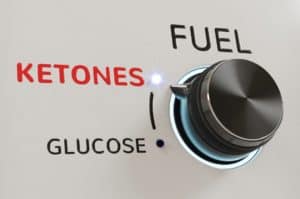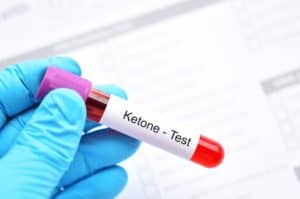What is Ketosis
Ketosis is a natural metabolic process that occurs during the use of fat as an energy source.
Ketones are produced when the body begins to break down fats in order to produce more energy.
This article will discuss what ketosis is, how it affects your body, and how you can measure if you are in a state of ketosis.
The Definition of Ketosis
 Ketones are byproducts created as your liver breaks down fatty acids for energy production from fat stores.
Ketones are byproducts created as your liver breaks down fatty acids for energy production from fat stores.
In other words, they’re created when you don’t have enough glucose or sugar available for your cells to burn for fuel (i.e., because your blood sugar has been low).
When this happens, fats stored in fat cells throughout the body are released for energy production, and your body switches from using glycogen as fuel to using fats, and the ketones that are created by this process become the fuel for your brain and body.
Ketosis and the Keto Diet
Keto is a popular and trendy diet that follows a ketogenic plan .
.
It’s an eating style where you get the majority of your energy from healthy fats, which usually means foods like avocado oil mayonnaise or olive-oil-based salad dressing or animal fats from foods like bacon and eggs, beef, pork, etc.
On this type of low carb high protein lifestyle program, it is typical to eat around 50 grams per day maximum – 100 calories worth) carbs.
This ketogenic diet approach does not produce enough fuel in the form of glucose after conversion in the liver.
This puts the body into a state of ketosis where ketones are now the fuel source for brain function instead of glucose (Studies show that it is even more efficient than glucose) (Source)
Ketosis caused by ketogenic diets is called nutritional ketosis. This is what the keto practitioners strive for. If you achieve ketosis you’ve achieved low carb diet nirvana.
What are the Health Benefits of Ketosis?
A ketogenic plan includes a lot of healthy fats and it is now being studied for its possible health benefits.
Some research has found that the diet could help with: Cancer, Epilepsy/Seizures (especially in children), Alzheimer’s Disease or Other Dementia Disorders; Parkinson’s disease symptoms such as tremors ̶ confusion – stiffness, etc., Acne Rosacea & Psoriasis Inflammation Reduction from Diabetes Type II Symptoms to Migraine Headache Relief …and more!
It can also lead to weight loss when combined with a caloric deficit which also leads us into Ketosis when our brains use ketones instead of glucose as fuel.
Your brain runs more efficiently when you use ketones as fuel and that is the reason many people experience mental clarity while on a ketogenic diet.
It’s basically the same as fasting because that is essentially what you are doing while fasting you use ketones as fuel as it burns fat as fuel. Make sure to check out our article on Ketogenic diet myths as we separate fact from fiction.
What are Ketosis Symptoms and Side Effects?
Ketosis can cause some side effects.
Some of the most common include
- Headache
- Constipation ̶ Diarrhea (depending on how much fiber you eat)
- Excessive Thirst
- Increased Urination
- Difficulty Sleeping
- Loss Of Appreciation For Food
- Brain Fog –
- Bad Breath
- Body Odor Due To Ketones Producing Acidic Chemicals That are Excreted From The Skin!
These Side Effects May Be Temporary And Easily Managed If You Follow a Low Carbohydrate Diet Correctly.
This is typically experienced the first week of a keto diet and slowly goes away. Drinking plenty of water can ease or eliminate these side effects.
Ketosis vs. Ketoacidosis
Ketosis is a natural process that the body initiates to help us survive when food intake or carbs are low.
Ketosis caused by ketogenic diets is called nutritional ketosis. This is what low-carb dieters typically strive for.
Ketoacidosis occurs in uncontrolled diabetes and causes high blood sugar levels, which can lead to unconsciousness while ketones reduce insulin production from our pancreas (decaying beta cells) – this leads people with type 1 diabetes into a diabetic coma as their glycogen stores run out too quickly!
Type two diabetics notice these symptoms if they don’t take care of themselves through starving off glucose via dieting before it’s gone for good.
If you have diabetes that isn’t under control ketosis can be dangerous, however, if you do not have diabetes and follow a healthy low carb diet this should not be a problem.
Test your Ketones
How do you know you’re in Ketosis?
You can check how much ketosis is going on in your body by testing your blood, breath, or urine with a ketone meter or if you’re looking for something cheap (But not as accurate) you can use what’s called keto strip which will measure ketones in your urine.
You can also use the Keto-Mojo Ketosis Monitor to measure and track how much you’re going into nutritional/diabetic shock by looking at an easy color chart on their app!
I would recommend this if it’s not clear where along that low carb spectrum of dieting is best for YOUR body type based on what we’ve covered so far. in my blog post about using fasting as a key element towards effective weight loss.
Using Urine, Blood, and Breath to Measure Ketones
You Can review the blog post on measuring ketones. We look at all the different ways to test your levels of ketosis.
Is it Bad to be in Ketosis?
No as a matter of fact studies show that a ketogenic diet is safe and may even have health boosting qualities.
If you are in good health and not a diabetic you can be in ketosis for as long as you like!
While some experts argue that because of the high-fat content of the keto diet you should only practice keto for short periods of time. Some people follow a keto lifestyle for years with no detrimental effects.
How Long Does It Take To Get Into Ketosis?
If you’ve been eating less than 50 grams of carbs per day and haven’t started to experience ketosis yet, don’t worry! Many people take 2-4 days before entering the state.
It typically takes between two and four days for your body to enter into a ketogenic state if you’re on a low carb diet like Atkins or The Ketogenic Diet but it can sometimes be up to a week or longer depending on factors such as age, calorie intake from protein sources (i.e., chicken), metabolism. (1 )(2
)(2 )
)
[grwebform url=”https://app.getresponse.com/view_webform_v2.js?u=yhX3C&webforms_id=27444203″ css=”on” center=”off” center_margin=”200″/]
What is The Ketosis Flu?
The ketosis flu or the keto Flu as it’s known is a nasty side effect that many experiences when they first embark on the keto diet.
It can cause everything from nausea, headaches, and fatigue to dizziness!
If you are just starting with a keto or low carb diet be prepared for these symptoms because it’s likely your body is getting used not only to low carb.
Your body is literally switching metabolic processes as you switch from glucose to fats as fuel.
Some causes could be the following
- Losing electrolytes from water loss and dehydration
- Withdrawals from sugars
- Lack of vitamins or other micronutrients
- Adaption to using fat as fuel rather than glucose (Sugars)
The good news though? Ketosis flu typically subsides after a few days or max a week as your body adapts.
Just make sure you drink plenty of water and add a pinch of sea salt to make sure you keep your electrolytes at an optimal level.
Here are 3 ways to prevent or treat the Ketosis Flu
1 Drink plenty of liquids.
When you on a low-carb diet such as keto you will shed a lot of water weight. This due to stored carbohydrates holds onto the water in your cells.
For every one gram of carbohydrate stored in the body (as glycogen), there are approximately 2-3 grams of water retained.
So as you can see if deplete the stored carbohydrates you will lose a lot of water. Typically that is seen in low carbers as they experience a quick weight loss at the beginning of the Ketogenic diet or any low-carb diet. This is mostly water weight, unfortunately. But it’s a great tool for motivation as you see the scale moving.
We recommend up to 2 liters (at least half a gallon minimum)of water per day if you on the ketogenic diet just to make sure you’re not dehydrated.
2) Get your Electrolytes
Increase your intake of certain minerals when starting keto, to ensure you get enough. In particular, you’ll want more sodium, potassium, and magnesium.
While on a keto diet, your levels of insulin decrease since you don’t need it to control glucose and this causes your kidneys to release excess sodium along with the water so you lose your electrolytes that you need to replace to stay efficient.
The benefit of following the ketogenic diet is that it forces one’s metabolism into burning fat instead of carbohydrates for fuel; this can help with weight loss as well as health issues like diabetes or epilepsy.
But on top of having an increased need for certain nutrients (like sodium), there may be some risks associated with going low-carb too soon after quitting sugars: insulin levels decrease while dietary restrictions restrict many foods high in potassium used by cells to create energy via ATP synthesis
To battle these keto side effects, eat potassium-rich foods that are allowed on the diet. The best part is many of them also happen to be high in magnesium!
These can especially help if you’re having trouble sleeping or muscle cramps. I like to add Soy sauce to my condiment arsenal and I supplement with potassium and magnesium.
3) Get your Sleep
Cortisol is a hormone that can be raised when you don’t get enough sleep. It has been known to negatively affect mood and make keto-flu symptoms such as fatigue, irritability, headache, nausea worse.
To ensure restful nights of sleep: avoid caffeine later in the day; put calming bedtime rituals into place (read a book or take an Epsom salt bath). Always factor 7-8 hours per night for optimal health!
4) Are you getting enough Fats?
The keto diet is the ultimate weight loss tool, but you need to know how and when to add fat.
The higher-fat plan starts with about 75% of your calories coming from fat sources like meats, eggs, or oils.
To keep up this high-fat lifestyle for long-term success we recommend using a keto calculator so that you can calculate exactly what macros are best suited for you!
Feeling out of it? Find your way back to feeling energized and revitalized with these tips.
It’s no surprise that the keto flu has many people questioning whether or not they made a wise decision in starting their diet, but don’t let this give you second thoughts!
It is important to remember all the benefits of going ketogenic when dealing with what feels like an endless list of symptoms: weight loss (and more!), improved blood sugar levels, better mental clarity, and mood swings.
Not only will following through making sure that those pesky side effects are just temporary – once you’re past them -you’ll never have anything to worry about again…well except for avoiding carbs 😉
Make sure you check out this blog post on Keto and Alcohol.
Recent Posts
How To Reverse Fatty Liver Disease Through Diet (7 Day Sample Diet)!
Is A Fatty Liver Reversible? Fatty Liver Diet Plan and Menu Here we tell you everything you need to know about the fatty liver diet, menu, recipes, tips, and tricks. Did you just get diagnosed...
How to lose weight for teenage girls. A complete guide with tips
Lose weight and surprise your friends with your transformation. Follow our exclusive weight loss tips, healthy diet, and workout routine for teenage girls-all backed by science and recommended by...



